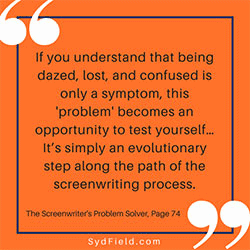Hitting the Wall – An Opportunity
For many writers, the start of a new year is the time to set deadlines for the next twelve months. You may have hit all the deadlines you charted the previous January, or maybe not. The dawn of a new year has such potential. There’s nothing to be done about the year gone by. Let it go. You either made your deadlines, or you didn’t.
As this year draws to a close, I made most of my deadlines. But before moving on to the coming year so full of possibilities, I decided to take a look back. How did I miss some of the deadlines I set for myself?
In Syd Field’s book The Screenwriter’s Problem Solver, I read something that helped me reconcile the progress of my writing, or intermittent lack thereof: “Writer’s Block. It happens all the time. To everybody. The difference is how you deal with it. How you see it.”
How did I deal with it? I did other things. I teach. I go to two different writer’s groups. I met friends for coffee. Read other people’s scripts. You know, things other than figuring out why I wasn’t finishing what I started. I basically, as Syd calls it, “hit the wall.”
Syd goes on to say: “If you can look at it [writer’s block] as an opportunity, you will find a way to strengthen and broaden your ability to create character and story. It shows you that maybe you need to go deeper into your story, and strive for another level of richness, full of texture and dimension.”
This brought me to a few critical questions. First of all, why tell this story? Why tell it now, at this point in time? Sometimes I find that I’m writing a story to make sense of a personal experience. Other times, it’s just an intriguing idea sprung from my subconscious or the zeitgeist or a response to something I’ve witnessed or read, and felt strongly that it needed to be dramatized. As Dr. Maya Angelou said: “There is no greater agony than bearing an untold story inside you.”
What was my untold story? Did I even have something to say? Of course, the inner critic has a few things to say about this. Things like, ‘What even made you think this was a good idea?’ Or something along the lines of ‘Why didn’t you take that Write-a-Screenplay-in-30-days” challenge? Actually, when I’ve tried those 30-day challenges, I can do them. It’s just those 30 days aren’t consecutive; I’d write five straight days one month, but only two the next, and none for six weeks, while other life situations took over, and on and on. I would be distracted and at loose ends. I’d need to pause and ask, ‘What was it I was trying to accomplish, again? ‘
This brought me to another quote of Syd’s, this one near the conclusion of his book Going to the Movies. Syd is speaking about why he teaches: “I wanted filmmakers to make great movies that would inspire audiences to find their common humanity.”
This statement hit a chord with me. “…inspire audiences to find their common humanity.” Wasn’t this why I became a storyteller? To make a connection? To understand the commonalities of the human experience no matter who we are?
Scientists and anthropologists tell us that we are a species of storytellers, even before the written word, as seen in prehistoric cave drawings. Apparently, we humans have always told stories to makes sense of the chaos and share whatever insights we’ve gleaned to connect with others. Stories are not merely entertainment – they are learning experiences, culture creators, expressions of the heart and compassion – stories tell us who we are. Or at least, who we hope to be.
We’ve evolved from drawings on cave walls, but that’s just an evolution of storytelling technology – from cave to screen.
Syd teaches: “Movies are all about story. No matter who we are, or where we live, or what generation we may belong to, the singular aspects of storytelling remain the same.
This is echoed by George Lucas, creator of Star Wars and Indiana Jones, and founder of Lucasfilm and Industrial Light & Magic, when he states: “A special effect without a story is a pretty boring thing.”
I followed Syd’s advice to look at writer’s block as an opportunity to go deeper into my story. Soon, it became clear that the block arose because I had become so caught up in the process of putting the words on paper, that I’d lost sight of why I was telling the story. I had to come back to the core purpose of writing a screenplay – to tell a good story.
The time it took to become re-acquainted with my initial inspiration was a release. The opportunity to step deeper into my character’s dramatic need allowed me to be firmly established in the origin of their journey and ultimate goal. Now, there is no wall to hit, only creative opportunities to explore. Perfect timing as I set deadlines for the coming year!
As we move into the New Year, may your writing flow with ease… and if you hit a wall, remember these words from Syd Field to carry you through:
“If you understand that being dazed, lost, and confused is only a symptom, this “problem” becomes an opportunity to test yourself. Isn’t that what life’s all about – putting yourself on the line in a situation where you test yourself to rise to another level? It’s simply an evolutionary step along the path of the screenwriting process.”
–The Screenwriter’s Problem Solver
Happy New Year!


Comments are closed.